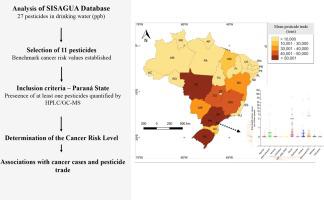Environment International ( IF 10.3 ) Pub Date : 2022-06-03 , DOI: 10.1016/j.envint.2022.107321 Carolina Panis 1 , Luciano Zanetti Pessôa Candiotto 2 , Shaiane Carla Gaboardi 3 , Susie Gurzenda 4 , Jurandir Cruz 5 , Marcia Castro 4 , Bernardo Lemos 6

|
Pesticides, which are associated with endocrine dysfunction, immunological dysregulation, and cancer, are widespread sources of drinking water contamination. The state of Paraná has a population of 11 million, is the second largest grain producer in Brazil and is a leading consumer of pesticides. In this study, we analyzed the extent of drinking water contamination from 11 proven, probable, or potentially carcinogenic pesticides (alachlor, aldrin-dieldrin, atrazine, chlordane, DDT-DDD-DDE, diuron, glyphosate-AMPA, lindane-γ-HCH, mancozeb-ETU, molinate, and trifluralin) in 127 grain-producing municipalities in the state of Paraná. Extensive contamination of drinking water was found, including legacy pesticides such as aldrin-dieldrin (mean 0.047 ppb), DDT-DDD-DDE (mean: 0.07), chlordane (mean: 0.181), and lindane-HCH (mean: 2.17). Most of the municipalities were significantly above the maximum limits for each one of the currently allowed pesticides (67% for alachlor, 9.44% for atrazine, 96.85% for diuron, 100% for glyphosate-AMPA, 80.31% for mancozeb-ETU, 91.33% for molinate, and 12.6% for trifluralin). Ninety-seven percent of municipalities presented a sum of all pesticides at levels significantly above (189.84 ppb) the European Union preconized limits (<0.5 ppb). Using the mean pesticide concentration in water (ppb), the exposed population for each municipality, and the benchmark cancer risk for pesticides, we estimated the minimum number of cancer cases attributable to pesticide-contaminated drinking water during the period (total of 542 cases). More than 80% were attributed to mancozeb-ETU and diuron. Glyphosate-AMPA and diuron-attributable cases strongly correlated with the total cancer cases in the same period (R = 0.8117 and 0.8138, respectively) as well as with breast cancer cases (R = 0.7695 and 0.7551, respectively). Water contamination was significantly correlated with the sum of the estimated cancer cases for all 11 pesticides detected in each city (R = 0.58 and p < 0.0001). These findings reveal extensive contamination of drinking water in the state of Paraná and suggest that contamination may increase the risk of cancer in this region.
中文翻译:

巴西饮用水中广泛的农药污染及其对癌症风险的影响
与内分泌功能障碍、免疫失调和癌症有关的农药是饮用水污染的广泛来源。巴拉那州拥有 1100 万人口,是巴西第二大粮食生产国,也是农药的主要消费国。在这项研究中,我们分析了 11 种已证实、可能或潜在致癌农药(甲草胺、艾氏剂-狄氏剂、阿特拉津、氯丹、DDT-DDD-DDE、敌草隆、草甘膦-AMPA、林丹-γ-HCH)对饮用水的污染程度、代森锰锌-ETU、禾本科和氟乐灵)在巴拉那州的 127 个粮食生产城市。发现饮用水存在广泛污染,包括遗留农药如艾氏剂-狄氏剂(平均 0.047 ppb)、滴滴涕-滴滴涕(平均:0.07)、氯丹(平均:0.181)和林丹-六氯环己烷(平均:2.17)。大多数城市的每一种当前允许使用的农药都大大超过了最高限量(甲草胺 67%,阿特拉津 9.44%,敌草隆 96.85%,草甘膦-AMPA 100%,代森锰锌-ETU 80.31%,91.33%禾草酸盐,氟乐灵 12.6%)。97% 的城市的所有杀虫剂总和显着高于(189.84 ppb)欧盟预先确定的限值(<0.5 ppb)。使用水中的平均农药浓度 (ppb)、每个城市的暴露人口和农药的基准癌症风险,我们估计了在此期间可归因于被农药污染的饮用水的最低癌症病例数(总共 542 例) . 超过 80% 归因于代森锰锌-ETU 和敌草隆。草甘膦-AMPA和敌草隆归因病例与同期癌症病例总数(分别为R = 0.8117和0.8138)以及乳腺癌病例(分别为R = 0.7695和0.7551)密切相关。水污染与每个城市检测到的所有 11 种农药的估计癌症病例总和显着相关(R = 0.58 和 p < 0.0001)。这些发现揭示了巴拉那州饮用水的广泛污染,并表明污染可能会增加该地区患癌症的风险。水污染与每个城市检测到的所有 11 种农药的估计癌症病例总和显着相关(R = 0.58 和 p < 0.0001)。这些发现揭示了巴拉那州饮用水的广泛污染,并表明污染可能会增加该地区患癌症的风险。水污染与每个城市检测到的所有 11 种农药的估计癌症病例总和显着相关(R = 0.58 和 p < 0.0001)。这些发现揭示了巴拉那州饮用水的广泛污染,并表明污染可能会增加该地区患癌症的风险。











































 京公网安备 11010802027423号
京公网安备 11010802027423号